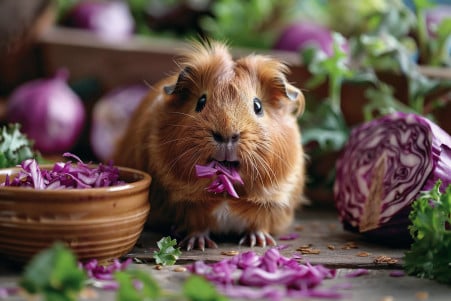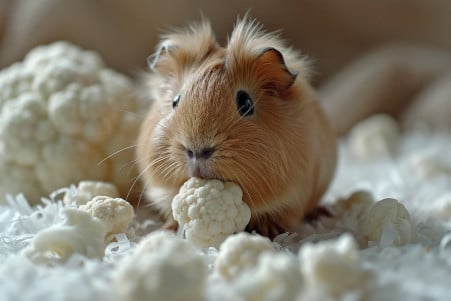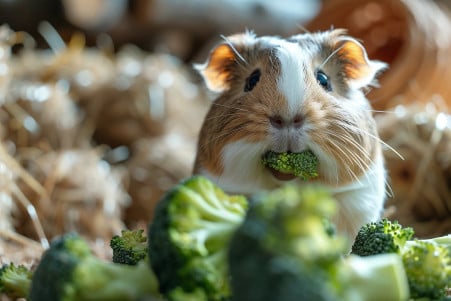Can Guinea Pigs Eat Cabbage? A Guide to Safe Feeding Practices
23 January 2024 • Updated 28 January 2024

Cabbage is a staple in many households, but is it a good option for your guinea pig? It turns out that guinea pigs can eat cabbage, and it even offers some important vitamins like vitamin C. However, it should be fed in moderation, with about one cup of fresh leaves two to three times a week, to avoid digestive upset and bloat.
In the sections below, we will take a deep dive into the extensive research that has been done by both veterinary science and animal nutrition experts. We will look at research that has been done on the dietary requirements of guinea pigs, the nutritional content of cabbage, and the effects of different vegetables on guinea pig diets.
This will give us a well-rounded understanding of how to safely add cabbage to your guinea pig’s diet, as well as some important information on how to make sure they get the nutrition they need.
Can guinea pigs eat cabbage?
Nutritional Facts and Health Benefits of Cabbage for Guinea Pigs
In addition to being a staple in the kitchen, cabbage is a nutritious addition to a guinea pig’s diet. It is high in vitamin C, which is especially important for guinea pigs since they can’t produce it on their own. Vitamin C helps support the immune system.
Cabbage also contains vitamin K, which is important for bone and teeth health, something that’s especially important for these small animals. The fiber in cabbage is good for digestion and helps keep their digestive system healthy.
That said, there are some things to watch out for. While the calcium in cabbage is important for nerve and muscle function, it can also cause problems. If your guinea pig eats too much cabbage, it can lead to urinary tract infections and kidney stones because the calcium can build up in the urinary system.
As recommended by Pet Keen and Guinea Pig Center, it’s important to make sure you’re feeding your guinea pig the right amount.
To ensure the best results, feed your guinea pig up to one cup of fresh cabbage leaves two to three times a week. While cabbage is good for guinea pigs, it’s important to remember that it shouldn’t replace the hay and pellets that are the main part of their diet.
These foods are the main source of fiber and other important nutrients that guinea pigs need. Because of this, they are essential. When you add cabbage to your guinea pig’s diet, make sure to watch them closely to make sure they don’t have any negative reactions and to make sure that it’s a good addition to their diet.
How to Feed Cabbage to Your Guinea Pig
Because of the potential for digestive issues, it’s important to introduce cabbage to your guinea pig’s diet slowly. Both GuineaDad and Guinea Pig 101 recommend starting with a small amount, like half a leaf, and then increasing the serving size if your guinea pig doesn’t have any negative reactions.
It’s also important to remember that cabbage should be fed in moderation, so one or two servings a week is plenty. Finally, make sure to wash the cabbage thoroughly to remove any pesticides or other chemicals and to cut out the hard stem, which can be hard for guinea pigs to digest.
After you’ve introduced cabbage to your guinea pig, make sure to keep a close eye on them to see how they react. According to Precisely Pets, bloating and diarrhea can be common side effects of cabbage consumption in guinea pigs, due to the high fiber content of the cruciferous vegetable.
If you notice any signs of discomfort or digestive issues, make sure to adjust their diet as needed, which may mean cutting back on the amount of cabbage you’re feeding them or how often you’re giving it to them.
If you follow these guidelines, you can make sure that cabbage is a safe and healthy addition to your guinea pig’s diet, providing them with important nutrients without causing any harm. This kind of thoughtful feeding is important to make sure that you’re maintaining the balance that’s necessary for your guinea pig’s digestive health.
How a Guinea Pig’s Digestive System Works
Guinea pigs have adapted to digest a diet that is high in fibrous plants, a requirement that dates back to their origins in the Andes Mountains. Their digestive system, which includes a large intestine that is different from other rodents and a caecum that is full of microbes, is designed to break down fibrous plants and extract the nutrients they need.
Supreme Petfoods explains that this is why their teeth continue to grow throughout their lives, to make up for the wear and tear of constant chewing.
One of the vitamins that guinea pigs need to get from their diet is Vitamin C. If guinea pigs don’t get enough Vitamin C, they can develop scurvy, which can cause swollen, painful gums, joint pain, and other health problems.
Cabbage, which is high in vitamin C, is a great way to meet a guinea pig’s dietary fiber needs, and it can help support their immune system and aid in digestion, according to the National Institutes of Health.
That said, it’s important to make sure that guinea pigs don’t eat too much cabbage, as it can lead to common digestive problems like bloat and diarrhea, according to a study in the journal PMC on gastrointestinal diseases in guinea pigs. This is a good example of why it’s important to make sure that guinea pigs’ diets are well-rounded and support their digestive health.
Creating a Balanced Diet Plan for Your Guinea Pig
In addition to keeping your guinea pig from getting bored with their meals, it’s important to make sure that they are getting a well-rounded diet. According to the Southern California Guinea Pig Rescue, eating the same vegetable every day can lead to nutrient deficiencies and other digestive issues.
To avoid this, make sure that you are feeding your guinea pig a variety of other vegetables in addition to cabbage. The RSPCA recommends feeding your guinea pig fresh, washed leafy greens like kale and broccoli, which are both high in vitamin C.
Make sure that your guinea pig is getting all of the nutrients that they need by planning a weekly menu that includes other vegetables like bell peppers, zucchini, and endive, as suggested by the PDSA.
Make sure that you are also providing a constant supply of hay, which is important for your guinea pig’s dental and digestive health. The PDSA also recommends that you make sure that your guinea pig has access to fresh grass, which is something that they would naturally eat in the wild.
Make sure that you are also feeding your guinea pig pellets that are fortified with vitamin C and that you are providing them with fresh water at all times. These are the most important parts of your guinea pig’s diet and are essential to their overall health.
By making sure that you are balancing all of these different parts of your guinea pig’s diet, you can make sure that you are keeping your pet healthy and happy, which is why it’s so important to be observant and responsible as a pet owner.
A Balanced Diet: Including Cabbage in Your Guinea Pig’s Diet
To sum up, cabbage can be a nutritious part of your guinea pig’s diet, especially since it’s high in vitamin C and fiber when fed in moderation.
However, as we’ve covered, it’s important to make sure you’re including cabbage in your guinea pig’s diet in a way that follows the recommended serving sizes and frequency to avoid the potential digestive problems that can come from the calcium in cabbage. A well-rounded diet for your pet will always be based on hay and pellets, with vegetables like cabbage being used to supplement and provide extra nutrients.
Being a good pet owner means paying attention to how your guinea pig reacts to new foods and adjusting their diet as needed. You’ll need to stay on top of this to make sure your guinea pig stays healthy and happy.
And always remember that you can talk to a vet to get personalized advice that’s tailored to your pet’s specific needs. They can help you make sure that you’re feeding your guinea pig a diet that’s nutritionally complete.
Taking a mindful approach to feeding and caring for your guinea pig will help you ensure that your pet is healthy and happy and will also help you build a stronger bond with your little friend.


